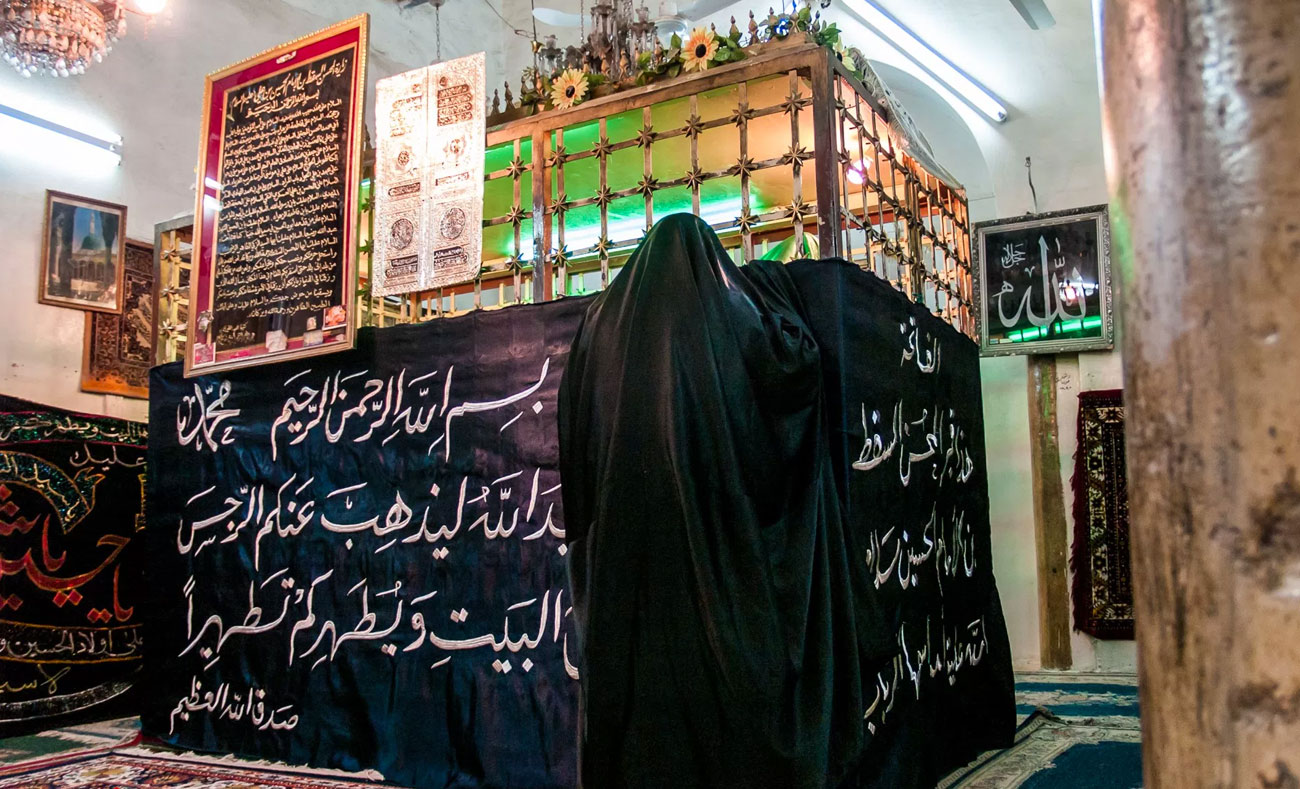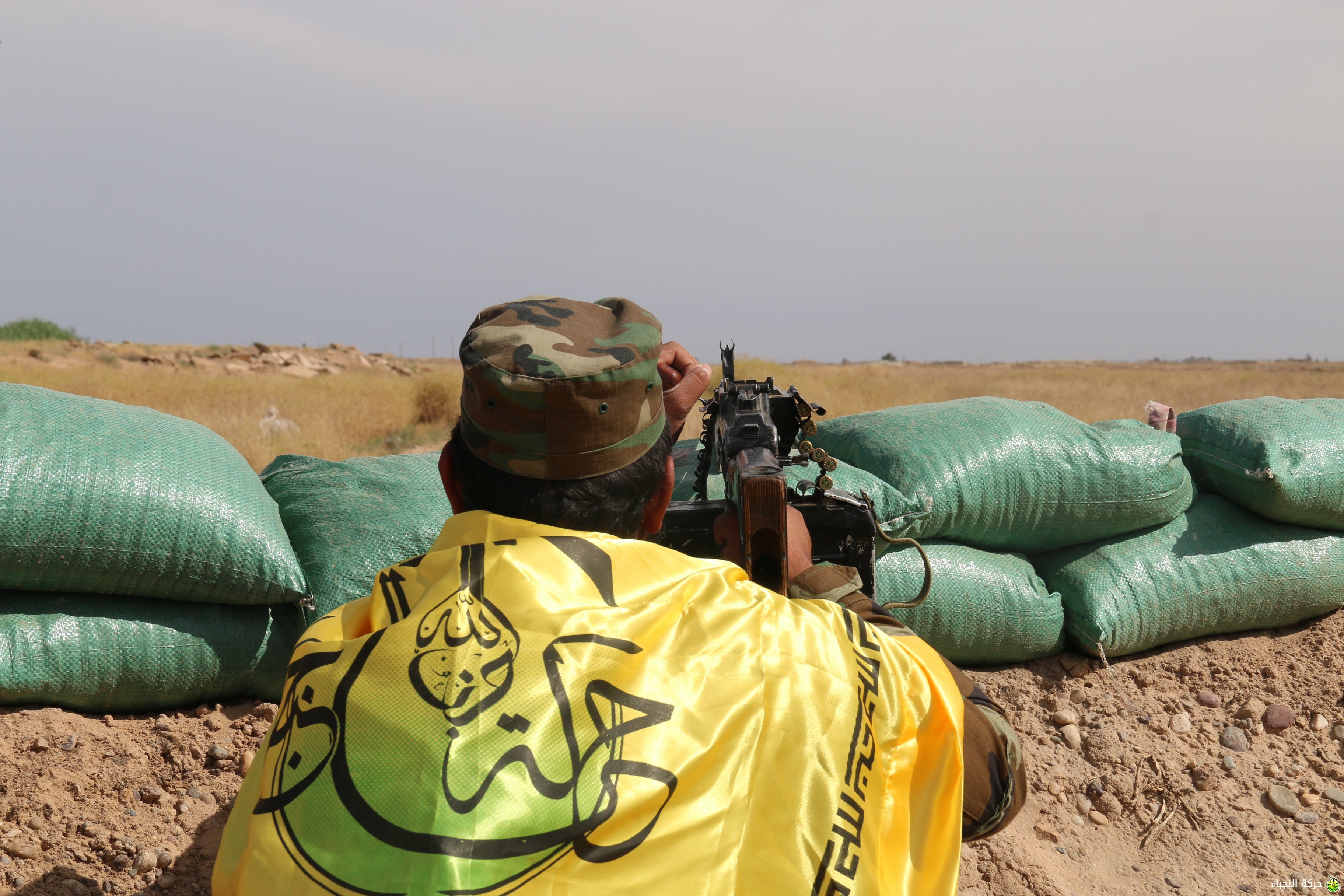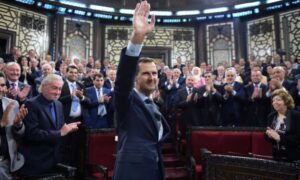Investigation team – Enab Baladi
In the pro-Syrian media, during the years of the revolution, Aleppo was “the most important economic city to which the army seeks to restore security and safety.” However,the western neighborhoods that remained under Assad’s control were “the civilized image of the Aleppo community.”
On the other side of the city, the regime punished the uprising of the people, and tried to burn residential neighborhoods, under the pretext of “fighting extraneous terrorism to rid the city of perpetrators.”
Behind the scenes, religious attempts to attract people to Shiism reached the regime-controlled areas in the city, as an extension of the Iranian project in Syria. The Assad forces were also fighting the opposition factions, supported with officers of the Iranian ,Iraqi, and Lebanese Shiite militias, which united the city under the frame of a “systematic Shiite targeting,” taking different military, ideological and demographic forms.
“The Shiite Shadow” in Aleppo after the Revolution
Repercussions of the Security Situation and the Impact of Demographic Change
Attempts at making people believe in Shiism in Aleppo may not be the same as those in Damascus, Homs and the Syrian coast in terms of proliferation, influence and clarity, but some details show that the city of Aleppo is connected to the “Iranian Shiite project” in Syria.
The appearance of Turbans in Shahba
The arrival of Shiite religious leaders in Aleppo coincided with the appearance of Shiite clerics on various occasions during the past few years in Aleppo while the pro-regime pages have been publishing photos of clerics from different religious communities in Aleppo to show a socalled “national cohesion.”
The presence of the Shiite within the city of Aleppo in the past was neither heavy nor remarkable, since the community was concentrated in the cities of Nubl and al-Zahraa of the province, but in the city, they were almost non-existent.
According to “T.N (31 years), who requested to be anonymous for security reasons, Shiite clerics arrive in and walk around Aleppo, but this scene is not widespread as it is concentrated in certain neighborhoodslike the case of the “Al-Nuqtah Mosque” (Masjid al-Nuqtah).
The young man who works at the University of Aleppo stressed that the covert existence of the Shiite clerics does not necessarily reflect their inexitence or their small numbers. However, their movements might rather be undeclared. He noted that people of the city are talking about a number of Sunni sheikhs who converted to Shiism, including Aleppo’s Mufti Mahmoud Akam.
Enab Baladi spoke to “Ahmed.S” who is a merchant having extensive relations with the sheiks of Aleppo, and who explained that officers of the National Defense and the “Hezbollah” militia, called Akam as ” Mawlana”, which confirms, according to him, the validity of the news about the Mufti of Aleppo’s conversion to Shiism.
Indicators of demographic change
Iran’s policy in Syria is currently centered on demographic change, instead of the ideological influence followed at the end of the last century and the beginning of the third millennium in Syria. This is linked to war and the military expansion in Syria which facilitates the rapid proliferation of the Iranian presence and its manipulation of Syrian territory.
In Aleppo, public projects under Iranian slogans may not be concretely noticed, like the “Organizing Mezzehorchards ” project in Damascus, but hidden movements on the level of real estate has begun to unfold in recent times.
Enab Baladi was able to obtain a document proving that a Palestinian woman, who recently became Shiite, purchased a number of properties in the city, on the grounds that her Palestinian family residing in Saudi Arabia would like to invest their money.
Mrs. M. K. was born in Handarat refugee camp. She is married to a Syrian man who is from Latakia and who belongs to the Alawite community. Local sources close to her confirmed that she purchased more than one property in the city after she returned from Lebanon carrying the ideas of Hezbollah.
However, these attempts may be limited and cannot be generalizable as a phenomenon in the city, as there has not been talk so far about large-scale investment projects, despite the talks about reconstruction. The gradual increase in the prices of real estate after the regime control over the city of Aleppo as well as the establishment of security in the city has equally leveled off the phenomenon of large real estate sales that invaded Aleppo between 2012 and 2015, as a result of the willingness of the people to leave the city.
Focus on children and adolescents
At the end of June, a celebration was held for children in Saadallah Al-Jabri Square in the center of Aleppo, to entertain children and offer them gifts for Eid al-Fitr. During the ceremony, the Lebanese Hezbollah flags were noticeably the most prominent sight in the arena and the loudspeakers were resounding songs whichpraised the party.
The ceremony, which aroused the anger of the residents there, was not widely covered by the pro-regime media, which was characterized by “crude forms” of sectarianism.
Trader Ahmed confirmed to Enab Baladi that there is a state of collective awareness among the population about the seriousness of the impact of such activities on children, pointing out that these phenomena are completely unacceptable in Aleppo society.
However, he added that the songs of the Shiite “militias”, often issued by pro-regime militia men, are now spread on teenagers’ mobile phones. Although it is a “fashion” according to Mr Ahmed, it can also be a threshold toward influence and manipulation.

Al-Assad fighters celebrate with residents of Nubl and Al-Zahraa after breaking the blocade of their towns north of Aleppo – Feb 4, 2016 (Reuters)
Militia Manifestation in Aleppo
“Shabiha” more than Forces of “Hezbollah”
The elements of sectarian militias can be distinguished in Aleppo through the various slogans that appear on the military uniform or from the flags and slogans raised on cars, and even through the type of songs heard from these cars.
In Aleppo, unlike Damascus, residents confirm that local militias are the most prevalent compared to sectarian militias, and that Hezbollah and Iraqi forces are always there to protect the “Al-Nuqtah Mosque” in the al-Mashhad neighborhood and other parts of the city.
According to Enab Baladi, the cars of sectarian militias in Aleppo are often covered from the back by Iranian flag, while Hezbollah members keep distinguished with yellow insignia.
In the two Shiite villages of Nubl and al-Zahraa close to Aleppo, local armed groups have been deployed since the beginning of the Syrian revolution. These groups are directly supported by Iran. Although they are considered as a military ally of the regime, the relationship between these armed groups and the Assad forces, and some sub-groups such as the Fourth Division and the Palestinian Jerusalem Brigade is still blurred.
This disturbance was evident when groups of Nubl and al-Zahraa blocked the road to Aleppo in July, in protest against the barriers of the Assad forces which imposed royalties on trucks carrying goods. This prompted the regime to respond to their demands, before it introduced more barriers of “Fourth Division” on the road to curb any similar moves.
Popular discontent in the city of Aleppo has recently risen over the military groups of the regime following attacks on citizens which have reached the point of “brutal” killing. This led the regime to restrict the militias and deploy officers of the Military Police and State Security in the city centers.
The deployment of security agents of the regime and the Russian “military police” in Aleppo are signs that the biggest influence in the city is that of the regime, with Russian support at the expense of the Iranian presence. The large banners hanging in the streets often carry photos of the regime’s president, Bashar al-Assad with the Russian President Vladimir Putin, while the photos of Hassan Nasrallah and Khomeini are raised on a smaller scale.
Between the state of Hamdania and the state of Assad … A slight impact of the Shia in the city of Aleppo
Before the arrival of Sayf al-Dawla al-Hamdani to the city of Aleppo in the fourth century of migration, the Shiites did not have a significant presence in the Levant. Historians talk about the era of the Hamdanid dynasty in Aleppo as a temporary and “short” period in the history of the spread of Shiism in the region.
The rule of the Hamdan family lasted about 60 years. Although the Hamdani policy was described as being “undogmatic” towards other sects, the prayer was held in mosques on the Jaafari doctrine. The period also witnessed several groups of people converting to Shiism.
After the collapse of the Hamdanid dynasty, it was the Fatimids who ruled in Aleppo and other areas of the Levant. The Fatimid Caliphate (al-Obeidiya) was known to follow the Ismaili faith, but their reign was full of political conflicts.
During that period, until the arrival of Saladin and the unification of the Levant, the Shiites in Syria formed groups trying to maintain their thought with the approach of the “danger of the new Sunni state” and the ensuing isolation.
The rule of the Ayyubid dynasty, and then the Ottoman Empire, had a profound impact on limiting the Shiite presence created by the Hamdanid dynasty.
Many Shiite historians refused to talk about the Shiite presence in Aleppo as a “sudden” event linked to the rule of Hamdan family. However, the historical evidence based on the physical monuments (the Shiite shrines) indicated their establishment by the Hamdanid family only during that period. The Syrian researcher specialized in history, Karam Nashar pointed out that “Aleppo occupied a marginal position in the Shiite imagination, despite the rule of Hamdan about 100 years ago, because it was not linked to any of the founding stages of the Shiite memory in the region nor to one of the prominent figures or martyrs of Ahl al-Bayt.”
This was true until the twentieth century. Syria’s population statistics for 1953 indicated that the percentage of Shiites throughout Syria did not exceed 0.4% of the total population. Aleppo, with the exception of individual cases, was not influenced by the limited Shiite Evangelism which accompanied Sheikh Mohsen al-Amin al-Husseini’s arrival from Jabal Amel in Lebanonand the foundation of the first Shiite school in Syria as the “Alawite School”.
As Baath Party came to power in Syria, regional and political factors forced Hafez al-Assad to remain cautiously close to Iran. Despite the role of al-Murtada Association, which was founded in Lattakia in 1981, Shiism movement reached a peak in Syria after 1999. This matter is linked to the growing relationship between al- Assad regime and Hezbollah in Lebanon.
One of the most prominent manifestations of the “Shiite evangelism” attempt in Aleppo was the participation of Deputy Secretary General of Hezbollah, Sheikh Naim Qassem, as part of the “Week of Islamic Unity” in al-Nuqtah Mosque in Aleppo. The celebration brought together 60 Shiites.
Important figures in al-Assad’s regime have been involved in “Shiism project” in Syria, which was supported by Iran. This project has manifested through the attempt to “make ministries abide by Shiism principles” and weaken Sunni religious schools as a way of supporting the Shiite. Two of Aleppo’s Sharia secondary schools were consequently closed.
According to statistics provided by the Syrian researcher Abd al-Rahman al-Hajj’s book, “The Shiite Baath”, around 16 thousand Syrians converted to the Shiism between 1919 and 2007, 10% of whom were in Aleppo province.
Speaking of Aleppo, it is worth mentioning that the city was not as affected by the large-scale Shiism conversion movement asthe countryside. Attempts to spread Shiism were centered within the city in al-Mashhad neighborhood (where the Al-Nuqtah Mosque is situated) and the Leiramon area, according to al-Hajj.
Aleppo Identity and war Legacy against the “Shiite Tide”
Interview with the Syrian Researcher Abd Al-Rahman Al-Hajj
The war caused deep cracks in the corners of the city of Aleppo, and left its prints on the shape of the city and the economic situation, and most importantly, it caused a disruption in the social structure.
On both sides of the city and despite their different goals and ideologies, the inhabitants were resisting war. . However, what is to their credit is t the long-term resistance they have shown and the strategies they have invented to maintain a minimum of a decent lifestyle and some social relations patterns which strengthened their sense of identity through resistance.
That identity has been used to “alienate the stranger,” although this does not seem entirely positive. However, since the 1980s, this attitude has been able to mitigate al-Baath’s attempts to impose a sectarian presence on the city and to try to expand the Shiite population since the 1990s.
During the Syrian revolution, and Iran’s attempts to implant the Shiite presence in Syria, Aleppo was an important target for the sectarian militias that supported the regime in its war against the opposition factions. However, the political deals were not in favor of the Iranians in Aleppo, resulting in limiting Shiism manifestations, which remained restricted to limited attempts that do not amount to those pursued by Iran in the capital, Homs and the area linking Damascus and the Syrian coast.
Although Iran’s focus on supporting the “Shiite arc” (or crescent) around the Lebanese border was greater, the existence of Shiite bases in Aleppo seemed necessary at some point to support the villages of Nubl and al-Zahraa in Aleppo countryside and to create Shiite strongholds in one of Syria’s largest cities.
Enab Baladi held an interview with Abd al-Rahman al-Hajj, a scholar, who wrote a book entitled “The Shiite Baath” in 2008. In this interview we tackled the opportunities of Shiite expansion in Aleppo, and discussed the reasons that would weaken those opportunities.
Economic Prosperity and the Nature of Religiosity
Al-Hajj pointed out that the economic factor has affected Aleppo’s failure to comply extensively with the attempts of Shiism during the last twenty years. The nature of the work of a large section of the Aleppo people in trade, and their good material status, made them far from interested in the search of beliefs.
The researcher stated that despite the religious trait of the city, this religiosity is only a part of an identity, a cultural complex, not an incentive for its people, so that their relationship with the clergy is not that of dependency.
“Aleppo’s people dumping into the material side led to their search for spiritual aspects, and created a sense of Sufism in their religiosity. Aleppo was not a suitable place for radical thought as Salafis thought was not introduced there but Shiism remained present on its outskirts.”
That relationship with religion made the people think of religious change as an undesirable fact. This situation remained part of the people of the city’s cultural heritage, upon which they could count in order to face some of the current attempts.
Since the situation in the countryside is different from that in the city, Shiism attempts were centered during the last century in the villages surrounding Aleppo, for example the village of Nuble.
After the revolution, and with the arrival of sectarian militias and al-Assad forces to Western Aleppo countryside, those militias’ members attempts to convert a group of inhabitants of Khan al-Asal and al-Mansoura into Shiism have been successful.
Absence of Holder and Caste Unity
The city of Aleppo is a predominantly Sunni in addition to a Christian section. The spread of Alawites was very limited and was restricted to some employees deployed in the cities of the Syrian coast. Al-Hajj referred to it as the “absence of the upper Alawites holder, ” which was used in other Syrian areas to strengthen the Shiite presence.
The “events of the Muslim Brotherhood” in the eighties of the last century and the siege upon the city following that event, was the break up signal of the relationship between Aleppo and the Alawites, and a good reason not to accept them in Aleppo society.
“The Shiite presence now is worse according to Aleppo perspectives, for the holders of the caste are foreigners, and when it is associated with converting faith, Aleppo people acceptance will be very difficult.”
“The Grace of Geography” puts Aleppo out of the “Arc”
On the basis of the different strategies the Iranians have worked on before and after the revolution, al-Hajj pointed out that before 2011 they focused on changing people’s faith and making some social changes and “Shiite evangelization.” After the war, however, the plan switched into controlling the land crossings to secure a point of contact between Iran, Syria and Lebanon, in addition to displacement, demographic change, and investment.
He explained that the Iranian operations in the capital, Homs and the area linking Damascus and the coast include displacement, naturalization and the purchase of real estate, hoping that these hotspots will protect the regime against any response to the military operation.
These areas serve the “Shiite arc” project, which aims at securing their access to Lebanese territory. Aleppo, which is close to the northern border, is not a strategic location for the deployment of the Shiite presence.
Al-Hajj further explained that “there is a weak presence in Aleppo. A small Shiite community can be formed, but it will be shunned. The city was devastated and won’t accept the Shiite presence anymore.”
Caste Leakage Movement
Contrary to what is expected, the events during the past seven years have not been fully in favor of the “Shiism project.” Iran’s involvement with al- Assad regime in the war against Syrian people has changed the view of those who converted into Shiism.”
“Some of those minorities of the supposedly Shiites were affected by the era of Hezbollah’s victories in the south. During the war they had a backlash and became militias fighting with the regime,” al-Hajj said. “This could generate leakage and anti-Shiite movement, but this movement is limited.”
Shiite Shrines in Aleppo
Al-Nuqtah Mosque
“Mashhad al-Nuqtah Mosque” is located on al-Jawshan Mountain in al-Mashhad area, within the eastern city of Aleppo. It is the most famous Shiite shrine in the city of Aleppo, which according to the Shiite narratives, dates back to the year 61 AH, or 680 AD, when Karbala famous battle took place.
The story says that Yazid bin Muawiya wanted to spread the news of the killing of Hussein after the battle. So he ordered to take the decapitated heads and the captivated to Syria to spread the news. Once the parade reached Aleppo through Kufa and Mosul, they put the head of Hussein on a rock above al-Jawshan Mountain near Aleppo so a blood drop fell on the rock, leading people to keep it, until the Hamdanids constructed a shrine for it later.
According to many historians, the mosque was built in the era of the Hamdanid state in the fourth century, as Yaqut al-Hamawi pointed out in his book “Mujam al-Buldan” that Mashhad al-Nuqtah was erected on the ruins of a Christian monastery, called Mart Marutha Abbey, following the orders of Sayf al-Dawla al-Hamdani.
At the end of the First World War, the mosque exploded after it had been used as an ammunition warehouse by the Ottoman army, and remained the same until 1958, according to Wikipedia, before the “Supreme Shiite reference” committed itself to rebuild the mosque, and then formed the Jaafari assembly of “Reconstruction and Islamic charity” in order to reconstruct “al-Mashhad”. It has been restored and rebuild and the rock was readjusted.
The first major Shiite celebration in the mosque took place in 2002, when the deputy secretary-general of the Lebanese Hezbollah came to al-Mashhad to participate in the Islamic Unity Week.
During the past years, the mosque was heavily destroyed. Opposition factions took control of al-Mashhad neighborhood in 2013 and were subsequently bombed. However, the Syrian regime quickly restored it after its takeover of the entire city of Aleppo at the end of 2016. It was opened last April in a ceremony attended by Shiite clergymen.
Mohsen bin Al-Hussein Shrine
Al-Mohsen Mashhad was mentioned only in the Shiite narratives. It is a shrine built upon Al-Jawshan Mountain which is also close to al- Nuqtah Mosque. Syrian historians point out that the shrine is primarily for an Imam named Mohsen. Some of the people of Aleppo believe that he was one of the righteous, as this place is located inside a historic long-standing Sunni mosque named after him.
The Forum of the Shiite novel says that al-Mashhad location contained “SabayaAhl Al-Bayt” after “the battle of Karbala” and when al-Hussein wife miscarried her baby and called him Mohsen. It also indicates that Sayf al-Dawla dug the place himself, and found a stone on which was written “this is the grave of Mohsen Bin al-Hussein ibn Ali ibn Abi Talib peace be upon them, “and then the Emir initiated the establishment of the shrine.
There is no information about the evidence of the establishment of the shrine except in some articles published on the sites of the “Shiite call”, although the place is neither mentioned in the urban heritage nor classified in the achievements attributed to the Hamdanids.
if you think the article contain wrong information or you have additional details Send Correction
النسخة العربية من المقال
-
Follow us :
Most viewed
- After Turkey and the opposition, SDF shows willingness to dialogue with Syrian regime
- Potential Erdoğan-Assad meeting in Moscow: Talks of excluding Iran
- Syrians pack their bags in Turkey
- European countries call for re-evaluation of policy towards Syria
- Al-Assad reproduces Constitutional Committee through People's Assembly


















 A
A
A
A
A
A









 More In-Depth
More In-Depth